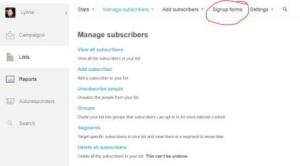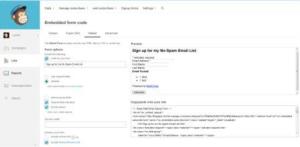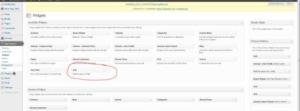 Let me say it right upfront: I hate emailed newsletters. Most businesses send them out far too frequently for my taste. I usually let them languish in my spam folder unless I’m in the market for something they’re selling. But with Facebook limiting the organic reach of posts (unless you pay them), a newsletter is one of the few free ways left for us to be certain that our fans get word of a new release.
Let me say it right upfront: I hate emailed newsletters. Most businesses send them out far too frequently for my taste. I usually let them languish in my spam folder unless I’m in the market for something they’re selling. But with Facebook limiting the organic reach of posts (unless you pay them), a newsletter is one of the few free ways left for us to be certain that our fans get word of a new release.
So when David Gaughran recommended MailChimp, I gave a lusty sigh, bit the bullet, and signed up. MailChimp is free for mailing lists with fewer than 2,000 addresses. The free service also limits the number of newsletters you can send out per year, but the limit is something like 800. I’m only intending to annoy people when I have a new book out, so I’m pretty sure I’ll be okay.
So now I have to get people to sign up for my list. I’ve already got some, but I’d sure like to have more. So I’m going to make a widget to put on my website. (Before we dive in, please note that what I’ve got is a WordPress.org, or self-hosted WordPress, site. I’m not sure what the differences would be for a WordPress.com blog. If you do know, let us all know in the comments, okay? Thanks!)
MailChimp recently redesigned their site, and while it looks all streamlined and uncluttered now, they’ve hidden a few things – including the link to the signup widgets. I poked around for quite a while before I stumbled across it on the “Lists” tab. See the drop-down arrow next to “Stats” on the far right? Let’s click that, and pick “Manage subscribers.”
 That brings us to this screen. I’ve gotten our own IU chimp to help me circle the “Signup forms” tab.
That brings us to this screen. I’ve gotten our own IU chimp to help me circle the “Signup forms” tab.
 If we click there, we come here. MailChimp gives us a number of options. “Form integrations” goes to a WordPress.org page where you can generate and install a widget on your WordPress.org site. That’s the kind of site I’ve got, but I always feel like the WordPress.org guys are speaking Greek, or maybe Urdu. So instead, let’s pick the pretty blue icon labeled “Embedded forms.”
If we click there, we come here. MailChimp gives us a number of options. “Form integrations” goes to a WordPress.org page where you can generate and install a widget on your WordPress.org site. That’s the kind of site I’ve got, but I always feel like the WordPress.org guys are speaking Greek, or maybe Urdu. So instead, let’s pick the pretty blue icon labeled “Embedded forms.”
 Before we leave this page, I want to point out the link for the Facebook signup widget, which I already have on my fan page. MailChimp also now has a tablet form, which I think would be terrific for book signings.
Before we leave this page, I want to point out the link for the Facebook signup widget, which I already have on my fan page. MailChimp also now has a tablet form, which I think would be terrific for book signings.
So here we are on the “Embedded forms” page. We’ve got four options for the look of our signup form: Classic (lots of white space), Super Slim (just the email address box), Naked (no fancy formatting), and Advanced (which scares me, so I’m not going to click it). Once we decide on the type of form we want, it’s pretty straightforward: any changes we make on the left will show up in the preview box on the right (although it might take a sec, depending on the speed of your internet connection). I’m now done tweaking it, so I’ll highlight all the hash in the “Copy/paste onto your site” box, right-click, and select “copy.”
 Now we get to load the code into my site. I’m going to pick the “Text” widget. I drag-and-dropped it to my primary sidebar, opened the widget, added my own headline (“No spam. No, really.”), pasted in the hash, and then hit Save and Close.
Now we get to load the code into my site. I’m going to pick the “Text” widget. I drag-and-dropped it to my primary sidebar, opened the widget, added my own headline (“No spam. No, really.”), pasted in the hash, and then hit Save and Close.
 And…done. Here’s how it looks on my site. You’d totally sign up for that, right?
And…done. Here’s how it looks on my site. You’d totally sign up for that, right?


This is a super tutorial. I signed up to MailChimp a while ago and got overwhelmed by it. The fact i had to get people to sign up to my list was too daunting for me. I hate bothering people so I gave up. I might have another go now. Pass the bananas
Here you go, Carol. 🙂 I know what you mean about getting people to sign up. I really ought to go back and put signup links in the author notes of all my books. One of these days…
My approach is to use MailChimp just for mailing (and cleaning lists) and gather leads elsewhere.
Sure, Lin, that works, too. Gathering e-mail addresses via a widget on your website or blog means you have to drive traffic there first. On the other hand, the folks who are there are self-selected to have at least a passing interest in your writing. So in theory, they’re “quality” leads.
That’s the thing about email marketing that makes if way trickier than direct mail with snail mail: EVERY name has to be qualified. It’s frustrating without any list swaps or brokers, but I’m figuring out ways to build lists without getting in trouble.
I’ve been debating this ever since I saw David’s post, too. I still can’t decide. Thanks for spelling it out, though. Just what I need to guide me through.
You’re welcome, Yvonne. 🙂
I am on the fence about setting myself up an account. Might go for it now, thanks.
The account setup is easy. One caveat: you will need to give them a physical address, and it will show up on any newsletters you send out (it’s US law). So if you don’t want your home address sent to all your adoring fans, you need to get a P.O. box. Which is another thing on my to-do list (sigh…).
Lynne, that’s the one thing that warned me off MailChimp; I did NOT want my physical address out there. I went with Tiny Letter instead. It’s more limited, but doesn’t require the physical address.
Thanks for that info, Lynne. I will probably rethink as my mother lives with us and is a vulnerable person. (sigh)
Thanks for this, Lynne. I’m definitely going to hold onto it until I work up my nerve. Like Carole, I’m afraid of bothering people, but I think you’re right. With the direction Facebook is taking, there might not be any other way to let people know when new books come out.
That’s the only reason I decided to start pushing the email signups, Melinda. Gotta get the word out somehow…
I’ve been meaning to get an email list started. Thanks for the tips, Lynne! (I’m sure I’ll be among the first to tell you if it doesn’t work on WordPress.com.)
D’oh! As I suspected, WordPress.com doesn’t like this. Sigh. It might be time to bite that bullet, too.
Rats! 🙁 Does WordPress.com have its own widget for adding e-mail signups? I think Blogger offers its own native one, but I opted for the MailChimp-generated one for my blog.
I do not understand the mechanics of our digital world, but I know people–paid and free who do, so I have a mailchimp sign up on my webpage/blog. Here is a fact: Every successful male indie author I know has a newsletter sign up. Men love gadgets, it is part of their psyche. Has nothing whatsoever to do with writing but it serves them well. I read the comments of the female authors in this thread. It reminded me of my ironing basket. I’d look at the last few shirts and pants and think: I’ve ironed enough for everybody to have a clean shirt every day. I’m done. That’s what we women do. But to be successful in our digital universe of ebooks, we’ve got to do the SCUT WORK. Every job I ever held had scut work. Revising a ms is scut work. I hate it, but I do it. David Gaughran has walked the walk. He’s knows what he’s talking about. He’s successful. I reread sections of his book often. As soon as I read his book, I revised all three of my indie titles, added that little gem of a gentle plea for reviews, a note to the readers–which is the only place we can really address our readers outside of third person–a book blurb for other titles, and all of my SOE links. David G. and Martin C. gave indie authors a pattern for success. It’s work. I’m new at this indie authorship and often dumb as rock, but I’m not so stupid as to ignore a pattern for success–however long or as much scut work it takes, especially since somebody else has already cut out the pattern. Once our titles have gone digital, they are on Amazon until the sun burns out or the Rapture into infinity. But since I’m not finite–I’m doing the scut work. I wrote those dang books. I want SOMEBODY to read ’em. Just sayin…
Okay, okay, I’ll go back and add the e-mail signup plea to all my books this weekend. 😉 Thanks for your comments, Jackie. And you’re right about Martin’s blueprint — the guy knows what he’s talking about.
Great article Lynne.
Thanks, alkaplan!
I’ve been using MailChimp for a while and you should know it was never designed to be an Aweber clone. The Chimp is for newsletters but not incessant e-mail marketing autoresponding.
If you’re having trouble making the widget work on WordPress dot whatever sites, try putting the eepurl hyperlink in a regular text widget.
YMMV, but I loves me my MailChimp 🙂
Thanks for the suggestion, M. Frank. I’ve had to use Blogger’s native widgets from time to time. I figured if Blogger had them, WordPress.com must have something similar.
Thanks for this, Lynne, I figure I’ll have to bite the bullet, in regard to mail sign up. I don’t have a WordPress site, I find WordPress all too invasive. And I must not be a typical male because gadgety things are definitely not part of my psyche. I also feel the same about asking (bothering) people as the girls.
Excellent tutorial, Lynne.
(Sweeping generalization alert! 🙂 ) I think most authors are bad at asking — for sales, for newsletter signups, etc. We aren’t salespeople and we’re not good at “the ask.” That’s probably the hardest part of marketing. For me, anyhow. YMMV.
Thanks, T.D.
Thank you, Lynne. I have been waiting for this. Apparently others have been, too! 🙂
And never let the “Advanced” options scare you! (This, coming from a non-techie!)
You’re welcome, Lorraine! I hope it helps. 🙂
Yes, it does. I’ve already signed up and have started a newsletter. I’m still learning how to navigate my way through the different options, but I’m making progress. Now, I’m making more progress, thanks to you. 😉
This was a great tutorial, but I couldn’t get the “submit” button to show up. Darn! I think it must’ve been something in the code Mailchimp generated. Anyone else have this problem?
Thanks, Kathlena. Are you talking about the “subscribe” button on the widget? Maybe one of our resident tech-savvy folks can help you out.
I just went to your site Kathlena and signed up, it seems to be working fine now, so whatever your problem was, you fixed it. 🙂
Thanks, Carolyn. Your signup did come through. 🙂 I ended up downloading the Mailchimp for WordPress plugin. I never could get that darned “subscribe” button to appear using the code Mailchimp provided. Probably doesn’t help that I don’t write code. Like Lynne, I’m not going there!
Just signed up, read the tutorial, still scratching my head. All I want to do is put some sort of link on my FB page so folks can sign up.
It’s under the “Signup forms” tab. The link for the Facebook signup widget is below the yellow icon. Let me know if you’re still having trouble, Kathy.